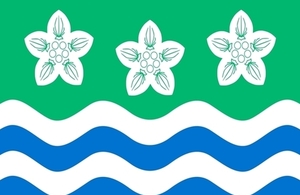Cumberland flag proudly flies at heart of government
The Cumberland flag has been hoisted outside the offices of the Department for Communities and Local Government to celebrate Cumberland Day.

Cumberland flag
Cumberland is a historic county of England dating from the 12th century. The first record of ‘Cumberland’ was in 945.
In 1974, the adminstrative council was combined with parts of Lancashire and the West Riding of Yorkshire to form part of the new county of Cumbria. However, the traditional county continues, and the name continues today most famously as in Cumberland sausage, the HMS Cumberland, nicknamed ‘The fighting sausage’, the Cumberland County Cricket Club, and as the local newspaper ‘The Cumberland News’.
Previously, many parts of Whitehall and municipal officialdom have shunned these counties, many of which date back over a thousand years of English history. Mr Pickles has previously announced that the government will seek to encourage the marking and continued use of such traditional county names.
He is encouraging local residents to continue to champion such local identities, irrespective of current tiers of local administration. Working with the independent Flag Institute, the government is also encouraging more local communities to create their own local flags.
Cumberland is predominantly rural and contains the Lake District and Lake District National Park, considered one of England’s most outstanding areas of natural beauty, serving as inspiration for artists, writers, and musicians.
At a ceremony of the hoisting of the Cumberland flag, Communities Secretary Eric Pickles said:
England’s counties continue to form an important part of our cultural and local identity in this country and many people remain deeply attached to their home county. This sense of pride and shared identity is one of the things that binds communities together. No amount of administrative tinkering with boundaries can change that.
I’m delighted my department is able to recognise and celebrate Cumberland Day by flying the flag of this historic county outside its headquarters.
Last year, Mr Pickles relaxed the rules relating to the flying of flags to make it easier for the public to fly a wider range of flags without the need for express consent which could cost up to £335. The changes will increase the number of flags that people can fly, promoting integration and community spirit.
Chris Johnson, Clerk of Alston Moor, said:
Flying the Cumberland flag for this day helps us celebrate an important part of our local Alston heritage and we can emphasise the diversity to Cumberland’s heritage that we bring. Alston Moor is such a special place, on the boundary of Cumberland and Cumbria, but the central hub of the trans-Pennine routes in the North Pennines Area of Outstanding Natural Beauty. Lead and silver mining has left us with a rich industrial heritage and our distinctive ‘miner-farmer’ landscape. We have traditional buildings and plenty of wide open spaces, making the area great walking country. To quote directly from a recent publication Alston Moor is somewhere to ‘re-discover a sense of adventure, a magical place to escape to and explore’.
Further information
Last year, Mr Pickles relaxed the rules relating to the flying of flags to make it easier for the public to fly a wider range of flags without the need for express consent which could cost up to £335. The changes will increase the number of flags that people can fly, promoting integration and community spirit.
Flying flags: a plain English guide - a guide to the flags that can be flown without permission from your local planning authority.
The Flag Institute guide to community flags aims to help communities design their own flags or organise a competition to design one.
Media enquiries
Email newsdesk@communities.gov.uk
Please use this number if you are a journalist wishing to speak to Press Office 0303 444 1209